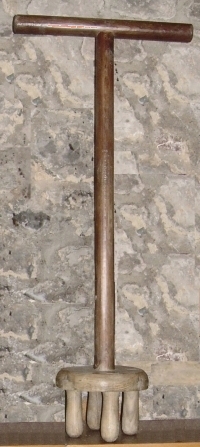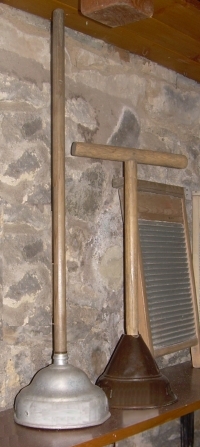-
History of:
- Resources about:
- More:
- Baby walkers
- Bakehouses
- Bed warmers
- Beer, ale mullers
- Besoms, broom-making
- Box, cabinet, and press beds
- Butter crocks, coolers
- Candle snuffers, tallow
- Clothes horses, airers
- Cooking on a peat fire
- Drying grounds
- Enamel cookware
- Fireplaces
- Irons for frills & ruffles
- Knitting sheaths, belts
- Laundry starch
- Log cabin beds
- Lye and chamber-lye
- Mangles
- Marseilles quilts
- Medieval beds
- Rag rugs
- Rushlights, dips & nips
- Straw mattresses
- Sugar cutters - nips & tongs
- Tablecloths
- Tinderboxes
- Washing bats and beetles
- Washing dollies
- List of all articles
Subscribe to RSS feed or get email updates.
Sheets were left on the boil for half an hour or so, and then, wet and steamy, would be heaved into the first sink with the washing dolly - a tough wooden stick strong enough to provide sufficent leverage without snapping.
Fay Weldon describing a New Zealand wash-day c1940, Auto da Fay: A Memoir, 2002
... posse it, rinse it, and hang it up as you did before...
Gervase Markham on bleaching newly-spun linen, The English House-wife, 1631
Dollies & possers
Washing dollies, peggy-legs, possers, poss-sticks
>>>> Similar punches and plungers here
 Anything anyone
says about laundry tools from pre-washing-machine times is going to apply to some
areas more than others. In England alone, there was a wide range of names for the
pieces of wood used to help get the household linen clean.
Anything anyone
says about laundry tools from pre-washing-machine times is going to apply to some
areas more than others. In England alone, there was a wide range of names for the
pieces of wood used to help get the household linen clean.
The milking-stool-on-a-broomstick contraption to the right is generally called a dolly nowadays, but was also a dolly-legs, dolly-pegs, peggy, or maiden, in different parts of Britain. The metal cones on a handle (left) are usually possers in the UK, or plungers in the US, but can also be called dollies, possing-sticks, or poshers. Some people used sticks with grooved blocks of wood on the end, called dollies or ponches. (For "punching" the laundry)
 All were for
agitating the cloth in a wash-tub, dolly-tub or possing-tub. Again, there were regional
variations in the way this was done, but we can see that the dolly with legs could
pound as well as stir.
All were for
agitating the cloth in a wash-tub, dolly-tub or possing-tub. Again, there were regional
variations in the way this was done, but we can see that the dolly with legs could
pound as well as stir.
The metal cone possers used suction to drive the water through the dirty clothing. Some had perforations to help the water circulate. They were more suitable for manufactured cotton clothes than earlier tools designed for linen, as only the heaviest cotton fabrics could take a beating from a big wooden dolly.
Not surprisingly, the laborious domestic chore associated with them doesn't seem to have inspired many writers until the later 20th century, when it could be viewed from a distance with nostalgia, or considered as social history. It's unclear when the dolly-legs started to take over from simpler stick shapes. There's not much in writing about it until 19th century scholarly gentlemen started collecting "dialect" words, and "discovered" dollies in many different regions of England, especially in the North and the Midlands.
Even Hannah Glasse's 1760
Servant's Directory
doesn't help us much. She seems to think a laundry-maid doesn't need much instruction,
since she would be "a Person brought up to it from her Childhood; for every poor
Woman teaches her Children to wash....". Washerwomen were at the bottom
of the heap. According to Glasse, all the finer clothes were the responsibility
of the lady's maid.
Two things you probably didn't know before about washing dollies:
1 -- A washing dolly features in a (modern) coat of arms.
2 -- A court case in 1900 in London decided that a washing dolly picture on the packaging of some laundry blue could stay there, even though the makers of the Dolly Blue brand claimed it was "passing off" another make of bluing as theirs.
Possing is an older word than dolly; it means beat down or thrust. There are early 17th century references to linen being possed, and to possing tubs, and the big Oxford English Dictionary quotes a 1764 source describing a posser as a "log of wood". The first written mention of a washing dolly is in the last decade of the 18th century, when the word started to apply to rods or paddles in early washing machines.
The plain wooden stick used for lifting the laundry from a tub of boiling water to a cold rinsing tub was also called a dolly or dolly-stick.
See also:
Washing beetles and bats
For more on on old laundry methods see:
History of laundry
Laundry from 1800
History of ironing
 5 September 2007
5 September 2007
You may like our new sister site Home Things Past where you'll find articles about antiques, vintage kitchen stuff, crafts, and other things to do with home life in the past. There's space for comments and discussion too. Please do take a look and add your thoughts. (Comments don't appear instantly.)
For sources please refer to the books page, and/or the excerpts quoted on the pages of this website, and note that many links lead to museum sites. Feel free to ask if you're looking for a specific reference - feedback is always welcome anyway. Unfortunately, it's not possible to help you with queries about prices or valuation.


